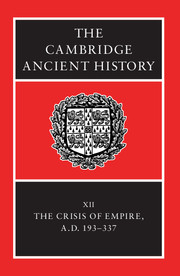Book contents
- Frontmatter
- PART I NARRATIVE
- PART II GOVERNMENT AND ADMINISTRATION
- PART III THE PROVINCES
- 8 Provinces and frontiers
- 9 Developments in provincial and local administration
- 10 Egypt from Septimius Severus to the death of Constantine
- PART IV THE ECONOMY OF THE EMPIRE
- PART V THE NON-ROMAN WORLD
- PART VI RELIGION, CULTURE AND SOCIETY
- Chronology
- Bibliography
- Index
- Topographical map of the Roman empire
- Map 2 The Roman empire in a.d. 211
- The Roman empire in a.d. 314
- The Rhine–Danube limes in the late second century
- References
9 - Developments in provincial and local administration
from PART III - THE PROVINCES
Published online by Cambridge University Press: 28 March 2008
- Frontmatter
- PART I NARRATIVE
- PART II GOVERNMENT AND ADMINISTRATION
- PART III THE PROVINCES
- 8 Provinces and frontiers
- 9 Developments in provincial and local administration
- 10 Egypt from Septimius Severus to the death of Constantine
- PART IV THE ECONOMY OF THE EMPIRE
- PART V THE NON-ROMAN WORLD
- PART VI RELIGION, CULTURE AND SOCIETY
- Chronology
- Bibliography
- Index
- Topographical map of the Roman empire
- Map 2 The Roman empire in a.d. 211
- The Roman empire in a.d. 314
- The Rhine–Danube limes in the late second century
- References
Summary
INTRODUCTION
What did it mean to be a ‘provincial’ for those who inhabited the Roman empire between the accession of Septimius Severus and the death of Constantine?
The period that concerns us here has long been defined by historians as one of transition between the ‘principate’ and the ‘dominate’, a transition that some have placed under the Severi, others under the tetrarchy, or even under Constantine. This period was said to be marked by a uniform and steady movement towards administrative centralization and bureaucratization, with all the negative connotations that were associated with those terms in nineteenth-century liberal thought. The very nature of the documents available led to this view of the matter. The high empire has left us nothing like the collection of public and administrative laws that is the Theodosian Code, or the catalogue of officers of the state that is the Notitia Dignitatum. The administrative history of the first two centuries of the empire is reduced, as a rule, to the study of the careers of the ruling personnel, while the actual practice of government remains hardly accessible. However, we should reject any idyllic notion of a ‘golden age of the Antonines’, which can only exaggerate the contrast with the subsequent epoch that begins with the Severi. The administrative records of the principate are already suggestive of the complex working of the state, the princeps' finicky supervision and the frequent clashes between administrators and administered: but their scarcity strengthens our impression – well-founded, moreover – of an apparatus of government that was remarkably light.
Keywords
- Type
- Chapter
- Information
- The Cambridge Ancient History , pp. 269 - 312Publisher: Cambridge University PressPrint publication year: 2005
References
- 24
- Cited by

